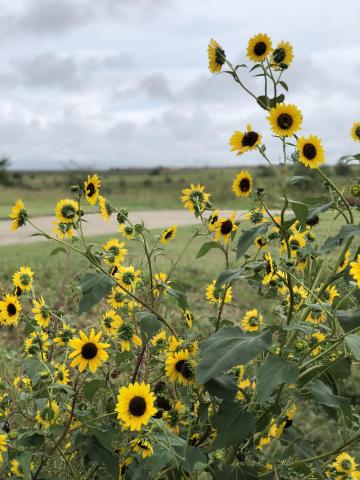
Sunflower Trails Across the Great Plains
“The road ran about like a wild thing, avoiding the deep draws, crossing them where they were wide and shallow. And all along it, wherever it looped or ran, the sunflowers grew; some of them were as big as little trees, with great rough leaves and many branches which bore dozens of blossoms. They made a golden ribbon across the prairie. Occasionally one of the horses would tear off with his teeth a plant full of blossoms, and walk along munching it, the flowers nodding in time to his bites as he ate down toward them.” —My Ántonia
When Jim Burden recalls the legend of “the sunflower-bordered roads to freedom” in My Ántonia, he remembers the story of Mormon settlers, scattering seeds along their trail so others could follow their path to the West. This speculative origin story obscures the sunflowers' true importance to this region. Nine species of sunflowers are native to the area, including the annual varieties Helianthus annuus and Helianthus petiolarus.
Mormon pioneers described finding sage and sunflowers in 1850s Utah "as far as the eye could see," according to an early account, and it's from these depictions that the myth of Western settlers using the colorful blooms as trail markers came to be. Cather directly referenced the trail on the Laramie Plain of Wyominng in The Song of the Lark, "where the wagon-trails of the Forty-niners and the Mormons were still visible." [There are worthy efforts now to preserve these literal tracks of history in the landscape.]
However, sunflowers were nothing new on the Plains. As early as 5,000 years ago, Native Americans domesticated the wild sunflowers and relied on the resulting plant for seed, for oil, and as a protective windbreak for their cultivated corn crops. Early Spanish explorers found sunflowers being grown by many of the tribes they visited in the 1500s and took those seeds with them as they returned to Europe. So what might give rise to the legend of the Mormon sunflowers? While it's hard to say for certain, it could be biology itself.
Sunflowers, because of their large compound flowers, create a much larger seed crop than other plants. Most sunflowers are perennial plants that return year after year in the same place, but the annual types grow from seed in the spring and encroach into disturbed soil—like wagon ruts—or in areas where hot, dry weather has killed or stunted prairie grasses. Under better conditions, the prairie grasses emerge again from their massive root systems, crowding out the opportunistic sunflowers that must start again from seed. In other words, settler activities—like driving wagons, clearing grass, or digging—create the perfect spaces for growing sunflowers!
"All the years that have passed have not dimmed my memory of that first glorious autumn. The new country lay open before me: there were no fences in those days, and I could choose my own way over the grass uplands, trusting the pony to get me home again. Sometimes I followed the sunflower-bordered roads. Fuchs told me that the sunflowers were introduced into that country by the Mormons; that at the time of the persecution, when they left Missouri and struck out into the wilderness to find a place where they could worship God in their own way, the members of the first exploring party, crossing the plains to Utah, scattered sunflower seeds as they went. The next summer, when the long trains of wagons came through with all the women and children, they had a sunflower trail to follow. I believe that botanists do not confirm Fuchs's story, but insist that the sunflower was native to those plains. Nevertheless, that legend has stuck in my mind, and sunflower-bordered roads always seem to me the roads to freedom."
When you visit Willa Cather's Red Cloud or the Willa Cather Memorial Prairie this fall, be sure to linger over the golden sunflower-bordered roads and share a moment that stretches across the history of the Plains!
